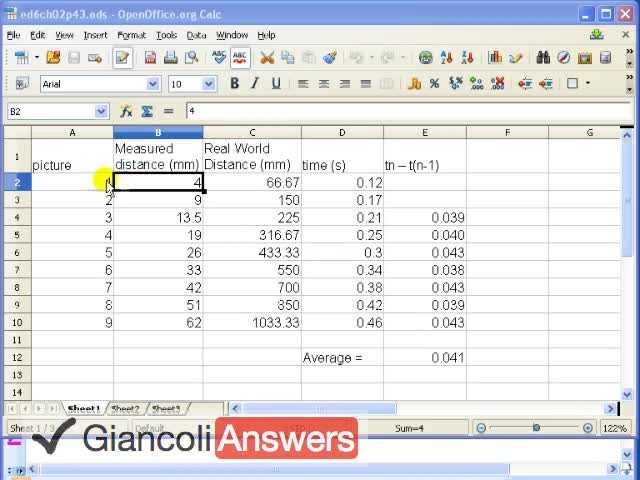

In order to watch this solution you need to have a subscription.
We’ll use a spreadsheet to figure out the time interval between pictures in that multi-flash photo. Here’s pictures one, two, three, four, and so on and I measured the distance on paper to the top of each apple from the bottom of the hand and we’re going to ignore these first couple of blank measurements of the time interval, the time in minus the time before it, the third time minus the second time for example, so it’s the time interval between two flashes. Where do these times come from? We need to understand this real world distance: if we measure thirteen and a half millimeters on the paper we need to convert that using the scale that the question gives us which is the apple is ten centimeters in diameter so we can use that as a way to get the scale. We know that ten centimeters is one hundred millimeters and the apple on the paper if you measure with a ruler is six millimeters in diameter, so that means one hundred millimeters in the world equals six millimeters on paper. So that’s the scale that we use for conversion, this is column b just the millimeters on paper that are measured and then column c is what I’m explaining right now, we’re going to convert this distance measured that's on paper to a real world distance so we’re multiplying ‘d’ by one hundred millimeters in the real world divided by six millimeters on paper and you’ll see that the millimeters on paper cancels with this millimeters on paper leaving us with one hundred millimeters in the real world. So now we have the real world distances that the apple has fallen at each of these pictures and from that we can figure out the length of time it would take to fall that height and that’s where column d comes in explained by that formula. Since the apple is dropped with an initial velocity of zero, we can use this formula: ‘d’ equals one half ‘a’ times ‘t’ squared and solving for ‘t’ multiple both sides by two and divide by ‘a’ and then square root gives the amount of time to free fall a certain distance ‘d’. So these are the times that it takes to fall to each of the heights shown in the picture and you can see the formula shown is written in the spreadsheet format. We also divide it by one thousand to convert millimeters into meters because the formula expects meters. Then we took the time interval and took the average of all these time intervals, which is zero point four one seconds and that’s the answer to our question.